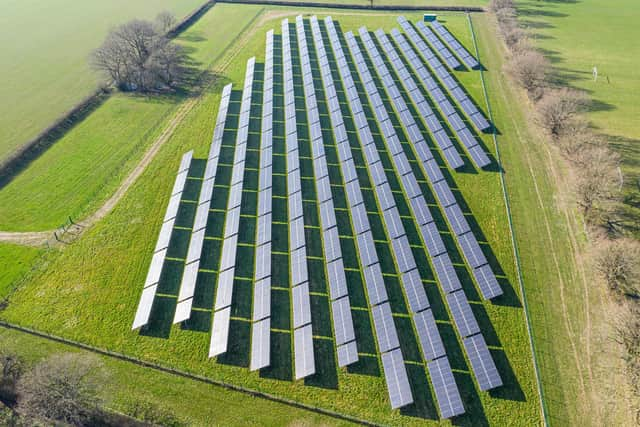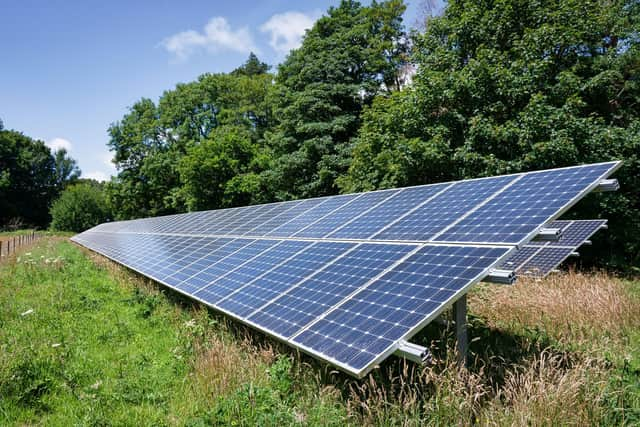Why Scotland is lagging far behind England on solar power developments
However, the country currently lags far behind England in solar generation with a huge north-south divide in the type of developments going ahead.
Scotland has a far greater number of onshore wind farms but only around three per cent of the UK’s total deployed solar generation capacity, despite having a third of the total landmass.
Advertisement
Hide AdAdvertisement
Hide AdOfficial UK government planning figures show just 20 of almost 300 new applications for ground-mounted solar PV schemes are north of the border.
Thomas McMillan, director of energy, renewables and infrastructure at Savills property agency and chair of trade association Solar Energy Scotland, insists there is a huge opportunity to increase the amount of solar being harvested.
“I would agree that solar farm deployment is low in Scotland compared to the rest of the UK,” he said.
“There is no reason why Scotland could not become a net exporter of solar energy in addition to it being a net exporter of wind energy.
“There is a huge reservoir of resource that remains untapped.”


Mr McMillan believes there are a number of factors to blame, including a mistaken assumption that there is not enough sunshine up north.
“There remains a misconception about the viability of solar in Scotland due to bias around Scottish weather conditions,” he said.
“If you take my home county of Fife on the East coast as an example, solar irradiance is 96 per cent of that found around Birmingham.


Advertisement
Hide AdAdvertisement
Hide Ad“Is this four per cent really the main contributing factor to the poor uptake of solar in Scotland?”
There has also been a greater emphasis placed on solar farms in England because onshore wind farms have become unviable due to the planning constraints imposed by the Westminster government.
Another potential reason for slow growth is a lack of connection capacity on Scotland’s grid, which has become more constrained due to the high level of wind already on the system – although network operators are working to resolve this issue.
Mr McMillan says both commercial-scale solar farms and rooftop schemes have big parts to play in decarbonising electricity and hitting Scottish and UK net-zero climate targets.


Solar Energy Scotland is calling for the Scottish Government’s new energy strategy to commit to a deployment target of a minimum of 4GW, with the ambition to reach 6GW by 2030.
As well as contributing towards net zero goals, analysis suggests up to 6,000 skilled green jobs would be created in the move.
The body projects that 3.5GW of the total 6GW capacity would come from solar farm and 2.5GW from rooftop panels – of this, 1.5GW would be mounted on residential properties and 1GW on business buildings.
Current deployment in Scotland is 522MW, with around 366MW rooftop and 156MW utility-scale.
Advertisement
Hide AdAdvertisement
Hide AdDomestic installations account for the lion’s share of rooftop panels in Scotland.
This is likely to be on account of fewer grid and planning barriers to deployment and favourable policies for new-builds, according to Mr McMillan.
But there is a long way to go, he says.
“Scottish solar has been sitting in the shadows of the wind sector for far too long,” he added. “We need to dispel the myth that solar is not a major resource in Scotland.
“An area the size of the Isle of Hoy receives enough sunlight to meet all of Scotland’s energy needs.
“Solar is price-competitive with wind power and accessible to homeowners who can generate their own electricity at a price that is cheaper than electricity from a utility supplier.
“It is time for Scotland to get its fair share of solar.”
Because solar is a modular technology, it can be implemented in many different ways.
“Solar allows many people to make a small contribution to a large target,” he said.
“It enables the power of the collective to make changes that help mitigate the climate crisis that is staring us in the face.
Advertisement
Hide AdAdvertisement
Hide Ad“Whether you are a homeowner, small or large business, local authority or a community group, solar has a role in helping you reduce your energy costs and carbon emissions.
“It is a key technology that needs to be embraced in Scotland to help us address the cost-of-living crisis – and with most rooftop projects now having a payback of less than five years there has never been a better time to install solar.”
The picture for solar in Scotland is in stark contrast to that for onshore wind farms, with 95 of the projects which have been approved or are under construction located north of the border – a total of 1,069 turbines, some at least 200m tall.
Only 20 of the consented schemes are in England.
Stephen Shelley, chief analyst at Barbour ABI, the UK’s leading provider of construction project information, agrees that planning regulations are having a major impact on the development of renewable projects.
“When it comes to onshore renewable energy generation there is a clear divide in the UK,” he said.
“Solar power dominates in England, whilst wind turbines dominate in Scotland and Northern Ireland.
“It’s not just about the weather – restrictive measures implemented by the UK government in 2015 effectively stopped onshore wind developments in England.
“In contrast, Scotland’s devolved government has implemented ambitious onshore wind targets to meet decarbonisation targets.
Advertisement
Hide AdAdvertisement
Hide Ad“This has resulted in an explosion in wind turbine projects in areas like the Scottish Highlands, Dumfries and Galloway and Strathclyde.
“In these locations planning data shows that giant wind turbines will become an increasingly common feature of the landscape.”
Comments
Want to join the conversation? Please or to comment on this article.